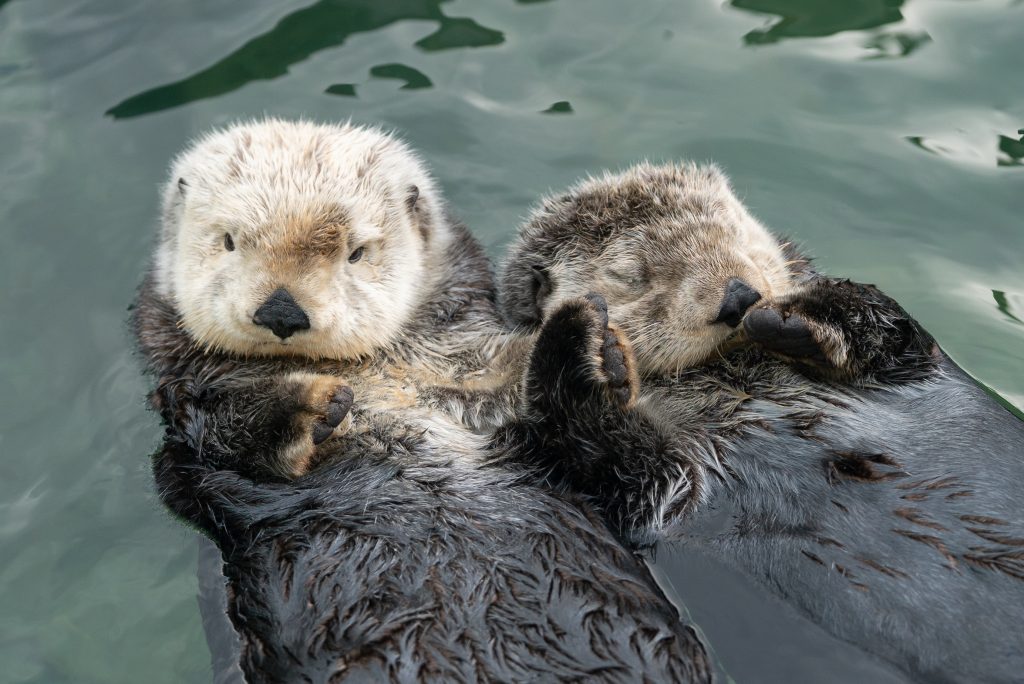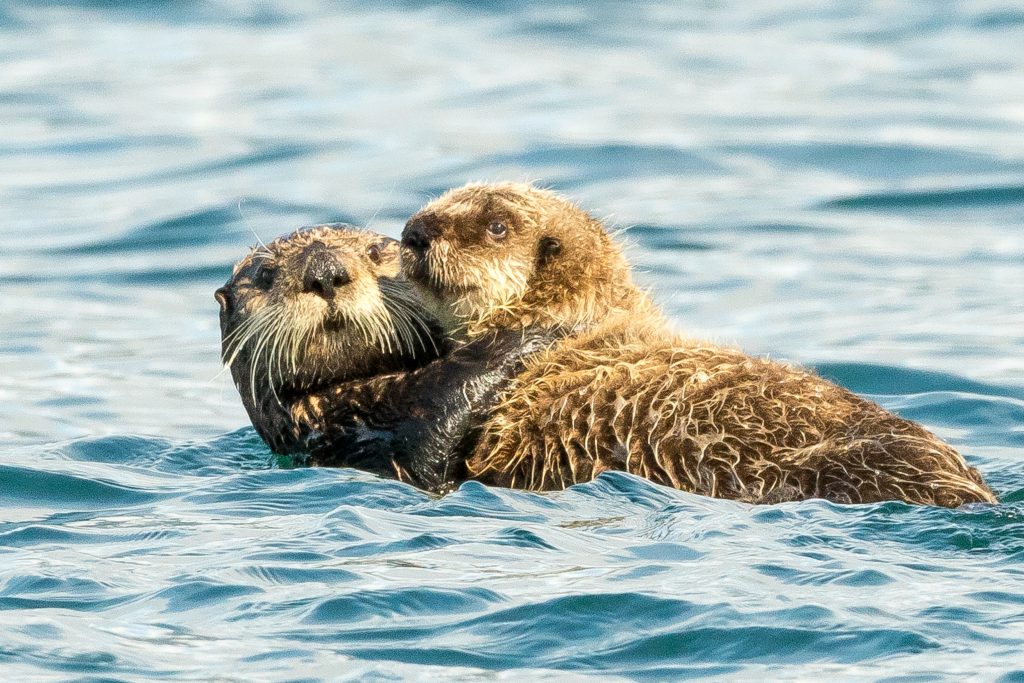Sea otters are one of the most captivating marine animals on the planet, and their reputation for forming lifelong bonds has fascinated scientists and nature lovers alike. These small yet powerful creatures are known not only for their playful nature but also for their deep commitment to their partners. Their behavior has long been studied, and the concept of "sea otters mate for life" has become a symbol of enduring love in the animal kingdom.
Despite their small size, sea otters have a significant role in maintaining the health of marine ecosystems. They are often referred to as keystone species due to their ability to regulate the populations of other marine animals. This article will delve into the fascinating world of sea otters, focusing on their mating habits, their lifelong partnerships, and the importance of these animals in the environment.
As we explore this topic, we will uncover the science behind why sea otters mate for life, how they form these bonds, and what this means for their survival. Whether you're a marine biology enthusiast or simply curious about nature, this article will provide you with valuable insights into the lives of these remarkable creatures.
Read also:Top Golf Courses Near Madison Wi A Golfers Paradise
Table of Contents
- Biography of Sea Otters
- Sea Otters Mating Habits
- Why Sea Otters Mate for Life
- Sea Otters' Role in the Environment
- Conservation Efforts for Sea Otters
- Threats to Sea Otters
- Interesting Facts About Sea Otters
- Scientific Research on Sea Otters
- Community Efforts to Protect Sea Otters
- Conclusion
Biography of Sea Otters
Sea otters (Enhydra lutris) are marine mammals native to the coasts of the northern and eastern North Pacific Ocean. They are the heaviest members of the weasel family but are among the smallest marine mammals. Known for their thick fur, which is the densest of any animal, sea otters rely on their coats for insulation rather than blubber, making them unique among marine animals.
Physical Characteristics
Sea otters have a distinctive appearance with their small, rounded heads, whiskers, and webbed feet. Adult sea otters typically weigh between 31 and 90 pounds, with males being larger than females. Their diet primarily consists of sea urchins, abalone, mussels, and clams, which they crack open using rocks, showcasing their intelligence and adaptability.
Behavioral Traits
Sea otters are known for their playful behavior, often seen floating on their backs, grooming themselves, and holding hands while sleeping to prevent drifting apart. This behavior is not only adorable but also serves a practical purpose, reinforcing social bonds.
Biological Data
| Characteristic | Details |
|---|---|
| Scientific Name | Enhydra lutris |
| Habitat | Coastal waters of the North Pacific Ocean |
| Diet | Sea urchins, abalone, mussels, clams |
| Lifespan | 10-20 years |
Sea Otters Mating Habits
The mating process of sea otters is both fascinating and complex. Unlike many other marine animals, sea otters exhibit monogamous behavior, often forming long-term bonds with their partners. This behavior is a key aspect of why the phrase "sea otters mate for life" resonates so strongly with researchers and nature enthusiasts.
How Do Sea Otters Mate?
Mating typically occurs in the water, with males initiating the process by gripping the female's head with their teeth. While this behavior may seem aggressive, it is a necessary part of the mating ritual. After mating, the pair may remain together for several days, reinforcing their bond through shared activities such as grooming and feeding.
Seasonal Mating Patterns
Sea otters do not have a specific breeding season, as they can mate throughout the year. However, peaks in mating activity are often observed during the spring and summer months. This timing aligns with the availability of food and favorable environmental conditions, increasing the chances of successful reproduction.
Read also:Easy Hairstyles For Straight Hair Effortless Ways To Enhance Your Look
Why Sea Otters Mate for Life
The concept of "sea otters mate for life" is rooted in their strong social bonds and the benefits these bonds provide. By forming lifelong partnerships, sea otters increase their chances of survival and reproductive success. These bonds are not only romantic but also practical, as they allow both partners to share responsibilities and resources.
Benefits of Lifelong Bonds
- Improved offspring survival rates
- Shared responsibility for hunting and protecting young
- Increased efficiency in foraging and resource sharing
Evolutionary Advantages
From an evolutionary perspective, forming lifelong bonds offers significant advantages. By maintaining stable partnerships, sea otters can focus on raising their young and ensuring the survival of their offspring. This behavior has contributed to the species' resilience and adaptability over time.
Sea Otters' Role in the Environment
Sea otters play a crucial role in maintaining the health of marine ecosystems. As keystone species, they regulate the populations of sea urchins and other herbivorous marine animals, preventing overgrazing of kelp forests. Kelp forests are vital habitats for countless marine species, and their preservation is essential for maintaining biodiversity.
Impact on Kelp Forests
Without sea otters, sea urchin populations would explode, leading to the destruction of kelp forests. This, in turn, would have cascading effects on the entire ecosystem, impacting everything from fish populations to coastal water quality. By controlling sea urchin populations, sea otters help maintain a balanced and thriving marine environment.
Conservation Efforts for Sea Otters
Despite their importance, sea otters face numerous threats, including habitat loss, pollution, and hunting. Conservation efforts are crucial to ensuring the survival of these remarkable animals. Various organizations and governments have implemented programs to protect sea otter populations and their habitats.
Key Conservation Initiatives
- Establishment of marine protected areas
- Regulation of fishing practices to reduce bycatch
- Public awareness campaigns to promote conservation
Threats to Sea Otters
Sea otters face a variety of threats that endanger their survival. Pollution, oil spills, and climate change are among the most significant challenges. Additionally, historical hunting for their fur has left some populations critically endangered, highlighting the need for continued conservation efforts.
Oil Spills and Pollution
Oil spills pose a severe threat to sea otters, as their fur loses its insulating properties when coated in oil. This can lead to hypothermia and death. Pollution, including plastic waste and chemical runoff, also poses significant risks to their health and habitat.
Interesting Facts About Sea Otters
Sea otters are not only fascinating for their lifelong bonds but also for their unique behaviors and adaptations. Here are some interesting facts about these amazing creatures:
- Sea otters are the only marine mammals that use tools, such as rocks, to break open shellfish.
- They have the thickest fur of any animal, with up to one million hairs per square inch.
- Sea otters are one of the few animals that sleep holding hands to prevent drifting apart.
Scientific Research on Sea Otters
Scientific research has shed light on many aspects of sea otter behavior and ecology. Studies have explored their mating habits, social structures, and ecological roles, providing valuable insights into their lives. Researchers continue to monitor sea otter populations to better understand their needs and challenges.
Recent Studies
A study published in the journal Marine Ecology Progress Series highlighted the importance of sea otters in maintaining kelp forest ecosystems. Another study by the U.S. Geological Survey examined the genetic diversity of sea otter populations, emphasizing the need for conservation efforts to preserve genetic variability.
Community Efforts to Protect Sea Otters
Communities around the world are taking action to protect sea otters and their habitats. Local initiatives, such as beach cleanups and educational programs, are helping to raise awareness and promote conservation. These efforts are crucial for ensuring the long-term survival of sea otters and the ecosystems they support.
How You Can Help
- Participate in local conservation programs
- Reduce plastic use to minimize pollution
- Support organizations dedicated to sea otter conservation
Conclusion
Sea otters are remarkable creatures whose lifelong bonds and ecological importance make them invaluable members of the marine world. The concept of "sea otters mate for life" is more than just a romantic notion; it represents a crucial aspect of their survival strategy. By understanding and protecting these animals, we can ensure their continued existence and the health of the ecosystems they inhabit.
We encourage you to share this article and spread awareness about the importance of sea otters. By taking action, whether through volunteering, reducing pollution, or supporting conservation efforts, we can all contribute to the protection of these amazing animals. Together, we can make a difference!



